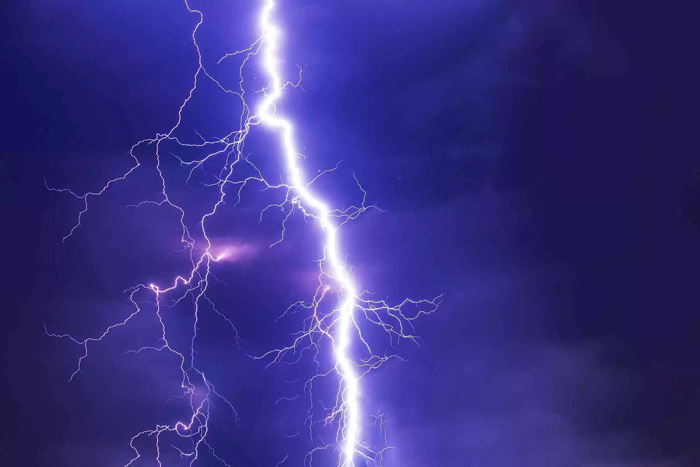Lightning is the electric discharge caused due to the collision of the storm clouds and the ground. It can also happen due to the collision within the clouds. In this phenomenon, the various particles of ice, snow, and rain collide with each other and create imbalances between the storm clouds and the ground. Consequently, the negatively charged particles reach the storm clouds. Due to which, the objects on the Earth like plants and trees become steeples. They act as a remedy by passing the current between the two charges. The surrounding air gradually expands and vibrate creating the thunder as a lightning flash.
Here we have listed some of the amazing facts about the lightning that you all should know:
13 Striking Facts About Lightning
- The sound which is caused due to lightning is called thunder. A charged and superheated lightning bolt creates a “resonating tube” as it travels through the air. The air in the tube rapidly contracts and expands to cause vibrations. These vibrations are known as the rumble of thunder.
- The lightning strikes can explode a tree on the surface of the Earth. The heat energy of the lightning bolt travels through the tree and vaporizes its sap. This creates a lot of steam that can explode the trunk.
- Lightning strikes at a rate of hundreds of times per hour at a specific place in the South American lake. The lightning bolt illuminates the sky above the intersection of the Lake Maracaibo and the Catatumbo River for more than 300 nights a year. The warm trade winds from the Caribbean Sea mix with the cool air descending from the Andes. This results in an unusual weather pattern that caused the most lightning bolts per square kilometer last year.
- Most lightning strikes average for about 2-3 miles long and carries a current of 10000 Amps at 100 million volts. When lightning strikes the rock and the sand, extreme heat is generated. This heat can fuse the minerals deep inside the earth’s crust in the form of a tube known as fulgurite. These “lightning fossils” can be found worldwide.
- People usually think that the lightning never strikes the same place again. However, it has been observed that it can strike the same place repeatedly. It mostly strikes on a tall, isolated, and pointy object.
- People also believe that if lightning strikes a human body, then it will electrify the body. And the affected person might be electrocuted. However, it is not true. The human body does not store the electricity. So, it is quite safe to touch the storm victim. And most importantly to give them first aid.
When Lightning Strikes
- People also think that you are completely safe from the storm if you are residing inside the house. But the fact is that you are completely safe inside your house during the storm, if you are not using anything that conducts electricity.
- Another myth is that the metal structures or the metal on the objects attract lightning strikes. However, science proves that the presence of metal has nothing to do it with the lightning strikes.
- Mostly the people who become the victim of the lightning strikes fail to look for a shelter or some safe place as soon as the thunderstorm starts. People should not stand underneath the trees as they cannot keep you safe and dry. It is actually another reason for more casualties.
- The people who are struck by lightning suffer from red Lichtenberg figures. Tree-like patterns appear on their skin which are created due to the passage of the high voltage electrical discharges along the skin.
- People also think that the rubber tires of the car can protect you from the thunderstorm. However, the fact is that the metal parts of the car will keep you safe during the lightning strikes.
- A single bolt of lightning is actually quite hot. It makes the temperature of the air around five times hotter than the surface of the sun. An average instance of lightning consists of 3-4 strikes. It lasts about a quarter of a second. About 50 to 100 Cloud-to-ground lightning strikes happen on the earth in a second worldwide.
- According to a study, the chances of being struck by lightning strike in your lifetime is 1 in 3,000. While the irrational fear of thunder and lightning is known as keraunophobia.
















